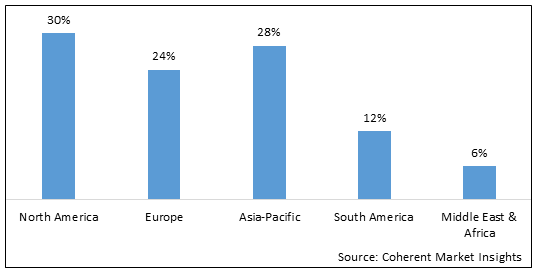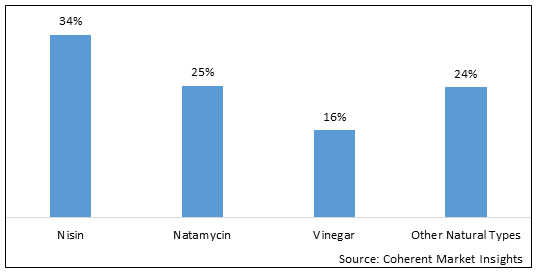Food Antimicrobial Additives Market is estimated to be valued at USD 434.0 Mn in 2025 and is expected to reach USD 680.2 Mn in 2032, exhibiting a compound annual growth rate (CAGR) of 6.63% from 2025 to 2032. Growing demand for clean-label preservatives and antimicrobials, such as vinegar, rosemary, and chemicals derived from organic or natural substances is driving growth of the food antimicrobial additives market. Moreover, growing demand for packaged fresh food products is further projected to augment market growth over the forecast period.
Global Food Antimicrobial Additives Market: Regional Insights
Regionally, North America is expected to dominate the global food antimicrobial additives market over the forecast period owing to the strong growth of food industry which has led to the increase in demand for food antimicrobial additives.
Europe is expected to witness fastest growth in the global market over the forecast period owing to the strong presence of key players offering wide range of antimicrobial for different applications. For instance, in Germany, Galactic produces and retails a range of antimicrobials, such as Galacid and Galaflow, formulated in liquid, powder, and crystalline forms for their extensive applications in the food industry.
Figure 1. Global Food Antimicrobial Additives Market (%), By Region, 2025

To learn more about this report, Download Free Sample
Global Food Antimicrobial Additives Market Drivers:
Growing awareness regarding food safety and quality among consumers
The Centre for Disease Control and Prevention (CDCP) has reported that one in 10 people fall sick due to foodborne illness every year, and most importantly, children under the age of five years are at high risk. Moreover, according to World Health Organization estimates on the global burden of foodborne diseases, around 125,000 children are dying every year, due to foodborne illnesses. The demand for these additives is attributed to the rising consumer awareness about food safety and quality, resulting in the need for improved hygiene standards.
Emergence of natural food antimicrobial solutions to augment market growth
For instance, in April 2019, Australia-based startup, Ingredient Trading Company (ITC), launched a natural food preservative range, Natalactin Plus and Nisilactin Plus. Nisilactin Plus is an antimicrobial agent that prevents the growth of gram-positive pathogens, while Natalactin Plus is a highly effective food preservative working against surface molds and fungi.
Global Food Antimicrobial Additives Market Opportunities:
Increasing population, disposable income, and the emergence of a large middle class are expected to provide significant growth opportunities for food antimicrobial additives market. Moreover, increasing prevalence of antibiotic-resistant bacteria, which leads to increased demand for antimicrobials in the end-use industries is further propelling market growth.
Growing consumption of dairy products is again projected to offer significant growth opportunities. World milk production is expected to increase by 1.6 percent annually between 2020 and 2029 and reach 997 million tons in 2029, according to a report prepared by OECD-FAO.
Global Food Antimicrobial Additives Market Trends:
Antimicrobial combinations hitting the mainstream
Several food and beverage producers have started using a combination of synthetic and natural food antimicrobials. Food giants, such as General Mills, Kraft Heinz, and Nestlé, are highly involved in reworking their recipes to eliminate artificial colors and flavors in order to offer more natural food products.
Increasing demand for food products with extended shelf life for improving customer experience
For instance, Lesaffre, a French global player in yeast and fermentation, offers a range of antimicrobial solutions for the food and beverage sector, to increase the shelf life of foods and beverages. These solutions encompass Encore Fresh and Encore Soft AM. Hence, growing demand for food product with extended shelf life is a growing trend for the global market.
Food Antimicrobial Additives Market Report Coverage
| Report Coverage | Details | ||
|---|---|---|---|
| Base Year: | 2024 | Market Size in 2025: | USD 434.0 Mn |
| Historical Data for: | 2020 To 2024 | Forecast Period: | 2025 To 2032 |
| Forecast Period 2025 to 2032 CAGR: | 6.63% | 2032 Value Projection: | USD 680.2 Mn |
| Geographies covered: |
|
||
| Segments covered: |
|
||
| Companies covered: |
Koninklijke DSM NV, The Archer Daniels Midland Company, BASF SE, DuPont de Nemours Inc., Corbion NV, Galactic, Jungbunzlauer Suisse AG, Celanese Corporation, Siveele BV, Shandong Freda Biotechnology Co. Ltd, Zhengzhou Bainafo Bioengineering Co. Ltd, Albemarle Corporation, Kerry Group, Third Wave Bioactives, and Mezzoni Foods |
||
| Growth Drivers: |
|
||
| Restraints & Challenges: |
|
||
Uncover macros and micros vetted on 75+ parameters: Get instant access to report
Global Food Antimicrobial Additives Market Restraints:
Growing market share of free-from preservatives food products is hampering sales
Food products bearing “free-from” claims are gradually reaching the retail shelves and food service menus, worldwide, due to increasing consumers conscious regarding the food and beverage products consumed. For instance, in July 2019, Storia Foods and Beverages launched a range of natural shakes with a refreshing twist to them. The fruit shakes are available in nine flavors and contain natural fruits and ingredients, with mango, banana, and strawberry being the highest fruit content shakes consumed in India. Storia states that shakes contain no preservatives and are trans-fat free. This is expected to decline the sale of antimicrobial additives, thus hindering market growth.
Strict regulations on the usage of food antimicrobial additives to restrict market growth
Antimicrobials in or on food packaging are used to extend the shelf life of the food or protect the packaging against microbial contamination. They are regulated as food additives under SS 201(q) (1) (B)(ii) of the Federal Food, Drug and Cosmetic Act (FFDCA), as amended by the Food and Drug Administration (FDA) Amendments Act of 1996 (ARTCA).
Figure 2. Global Food Antimicrobial Additives Market (%), By Segment, 2025
To learn more about this report, Download Free Sample
Global Food Antimicrobial Additives Market Segmentation:
The global food antimicrobial additives market report is segmented into type, application, and geography
Based on type, the market is segmented into Natural and Synthetic. Out of which, Natural is expected to dominate the global market over the forecast period and this is attributed to their safety and non-toxic grade. In natural segment nisin is gaining popularity as they exhibit high stability under acidic conditions. The nisin segment was valued at USD 123.01 million in 2025 and is projected to reach USD 226.13 million by 2032, registering a CAGR of 8.74% during the forecast period 2025-2032.
Synthetic segment is also expected to witness significant growth in the near future and this is owing to their high effectiveness and are also cheapest when compared to natural one. Sodium benzoate is one of the oldest chemical used as preservative in food industry. The benzoates segment was valued at USD 305.5 million in 2025 and is projected to reach USD 464.28 million by 2032, registering a CAGR of 5.54% during the forecast period 2025-2032.
Based on application, the market is segmented into Bakery and Confectionery, Dairy Products, Snacks and Savory, Beverages, Meat and Meat Products, and Other Applications. Out of which, Dairy Products is expected to dominate the global market over the forecast period and this is attributed to the increasing consumption of dairy products which is increasing preservatives for extending shelf-life of product. The dairy products segment of the antimicrobial market was valued at USD 343.4 million in 2025 and is projected to reach USD 500.67 million by 2032, registering a CAGR of 4.89% during the forecast period 2025-2032.
Bakery and Confectionery segment is also expected to witness significant growth in the near future and this is owing to the increasing usage in bakery product due extending shelf-life. Benzoates and sorbates are some of the antimicrobial widely used in confectionery. The bakery and confectionery segment of market was valued at USD 312.93 million in 2025 and is projected to reach USD 486.27 million by 2032, registering a CAGR of 5.89% during the forecast period (2025- 2032).
Global Food Antimicrobial Additives Market: Key Developments
In August 2018, Chinova Bioworks, a Canadian startup company, secured investment of USD 2 million from DSM Venturing BV. The investment was made for the launch of mushroom-based natural preservatives. The highly effective and natural anti-microbial product provides numerous multi-sector applications in the food industry.
In November 2019, DSM invested USD 166 million to acquire 100% interest from specialty dairy solutions provider Koninklijke CSK Food Enrichment (CSK). The acquisition was led by the company to strengthen its product range and application abilities in numerous food and beverage sectors, including taste, texture, and bio-preservation solutions for semi-hard cheeses.
In January 2019, DuPont Industrial Biosciences announced that they are expanding their research proficiencies in Leiden, the Netherlands at a new facility equipped with cutting-edge biotechnology laboratories. The launch will be beneficial for numerous societal issues, such as decreasing food waste; reducing the environmental impacts of livestock farming and enlightening animal health; producing renewable fuels and depressing environmental impacts in the textile and laundry industries.
In February 2019, DuPont Industrial Biosciences received regulatory approval for two MicroGARD products, MicroGARD 100 and MicroGARD 200, in Thailand from the Thai Food and Drug Administration (FDA). The product will improve profitability for food manufacturers in dairy, culinary, and bakery sectors.
Global Food Antimicrobial Additives Market: Key Companies Insights
The global food antimicrobial additives market is highly competitive. This is attributed to continuous launch of new technologies due to ongoing R &D and efforts by value chain participants. Moreover, key players are adopting various business growth strategies in order to expand their presence on regional as well as global basis. Some of the key players in the global food antimicrobial additives market are Koninklijke DSM NV, The Archer Daniels Midland Company, BASF SE, DuPont de Nemours Inc., Corbion NV, Galactic, Jungbunzlauer Suisse AG, Celanese Corporation, Siveele BV, Shandong Freda Biotechnology Co. Ltd, Zhengzhou Bainafo Bioengineering Co. Ltd, Albemarle Corporation, Kerry Group, Third Wave Bioactives, and Mezzoni Foods
*Definition: Antimicrobial additives are used to obstruct microbial growth and extend shelf life of food products. They can be either natural or synthetic and are added during various stages of the processing of a food product, such as pre-processing, post-processing, or both.
Share
Share
About Author
Shivam Bhutani has 6 years of experience in market research and strategy consulting. He is a Market Research Consultant with strong analytical background. He is currently an MBA candidate specializing in Business Analytics from BITS Pilani.
He is adept at navigating diverse roles from sales and marketing to research and strategy consulting. He excels in market estimation, competitive intelligence, pricing strategy, and primary research. He is skilled at analysing large datasets to provide precise insights, helping clients in achieving strategic transformation across various industries. He is skilled in leveraging data visualization techniques to drive innovation and enhance business processes.
Missing comfort of reading report in your local language? Find your preferred language :
Transform your Strategy with Exclusive Trending Reports :
Frequently Asked Questions
Select a License Type
Joining thousands of companies around the world committed to making the Excellent Business Solutions.
View All Our Clients